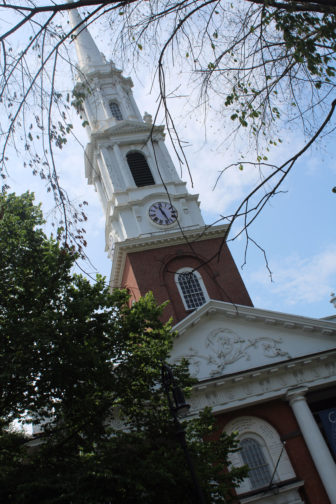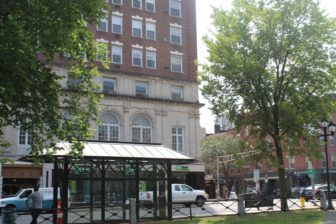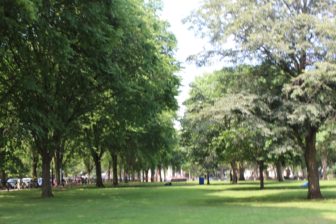Completed in 1638, the New Haven Green is the lively heart of the city’s downtown.
Originally known as the “marketplace,” it was surveyed and designed by Colonist John Brockett.
 Today, the green is filled with activity, excitement and many different faces. Throughout the 16-acre park, you will find people interacting with others, waiting for the city bus and sitting on the park benches. You’ll also find different summer camps huddling in groups and taking pictures of the things they find interesting.
Today, the green is filled with activity, excitement and many different faces. Throughout the 16-acre park, you will find people interacting with others, waiting for the city bus and sitting on the park benches. You’ll also find different summer camps huddling in groups and taking pictures of the things they find interesting.
The park is surrounded by many historical buildings. One of them is the United Church On The Green. Built in 1815, it was once the city’s main meeting house, where issues such as abolishing slavery, civil rights and environmental causes were discussed.
Between 1812 and 1816, three churches were built and remain standing today, the United Church, Center Church On The Green and Trinity Episcopal Church.
The oldest among them is Center Church, built in 1812. It has been built over the New Haven Crypt, which has the graves of the Puritan settlers and Revolutionary War soldiers.
Trinity Church was built in 1814 to 1816. United Church is located at the corner of Temple and Elm streets.
 The New Haven Green is well maintained and is a beautiful spot to take plenty of photos. On one side of the Lower Green stands an eye-catching tree that is tall, with a bumpy bark. The tree is located near a walkway, so many people stop to look at it.
The New Haven Green is well maintained and is a beautiful spot to take plenty of photos. On one side of the Lower Green stands an eye-catching tree that is tall, with a bumpy bark. The tree is located near a walkway, so many people stop to look at it.
In 1686, the first couple of elm and buttonwood trees were planted on the green. New Haven had the first public planting program, earning it the nickname of “The Elm City.” During the 1930s, Dutch Elm Disease caused many of the trees to weaken and die. The disease is caused by a fungus spread by bark beetles.
The New Haven Green is filled with people every day, including mothers walking with their children, older men playing guitars and families having a picnic.
“I go to the green almost every day,” a young woman said on a recent hot day. “It’s very relaxing to come and read at the table by the fountain.”
Before returning to her book, the woman said she feels safe there.
“I don’t see anything bad, like a crime when I’m here,” she said. “About five or so years ago, I remember seeing a guy walking on the green while swinging a machete in his hand.”
John, a man in his 50s, recalled damage to the green from a previous storm.
“Many years ago, Hurricane Sandy hit and made a terrible mess,” he said. “I heard that the storm made a historical tree fall, and people discovered something hidden among the tree.”
 He was correct. In 2012, Hurricane Sandy revealed a mystery the day before Halloween. An oak tree that was about 100 years old toppled over due to the winds that reached 80 mph. The tree, named for President Abraham Lincoln, was called the Lincoln Oak. The oak was planted in 1909, on the anniversary of his birthday. The facial bones of at least two people were found beneath the tree, along with a nail that belonged to some kind of coffin from the 18th-century, the New Haven Independent reported.
He was correct. In 2012, Hurricane Sandy revealed a mystery the day before Halloween. An oak tree that was about 100 years old toppled over due to the winds that reached 80 mph. The tree, named for President Abraham Lincoln, was called the Lincoln Oak. The oak was planted in 1909, on the anniversary of his birthday. The facial bones of at least two people were found beneath the tree, along with a nail that belonged to some kind of coffin from the 18th-century, the New Haven Independent reported.
Investigators worked to identify the sex, age and cause of death of the bodies, the website said.
“There may be more,” Yale University anthropologist Gary Aronsen said at the time.
From the 1650s to 1821, the green included a cemetery. The nail that looked like it belonged to a coffin, suggested that the bodies were buried sometime in the late 1700s, investigators said. The remains belonged to a victim of yellow fever or smallpox. There is a possibility that she could have been buried on the green between 1799 and 1821, the Independent reported.
Ashley-Ann Tanguay is a student at Wilby High School, Waterbury.